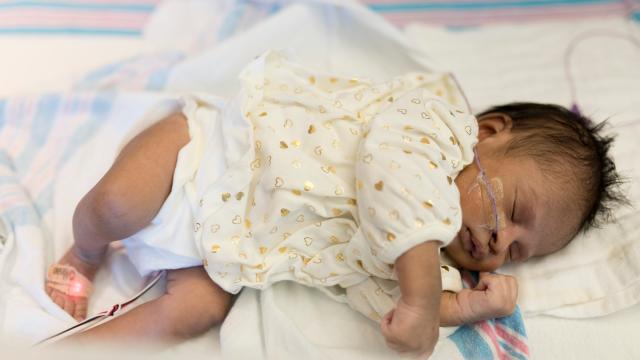Researchers in Chicago have seemingly found a much easier way for premature babies in intensive care to get the human touch and cuddles they need from their caregivers. This week, they introduced a system of wireless, low-irritation sensors that can be used to monitor a baby’s health from afar. The sensors, already being tested out in the real world, could someday replace and even outperform the cumbersome tangle of wires currently used in newborn intensive care units.
Babies born prematurely (before 39 to 40 weeks of pregnancy) are at higher risk for all sorts of health problems. So often their vital signs need to be watched closely in intensive care units before they can go home. Sadly, that requires them to be hooked up to a variety of machines with heavy wires. The wires can not only make it virtually impossible for parents to move or touch their children — a key moment of development that might actually boost the child’s health — but the tape used to secure these wires can also harm a premature newborn’s already fragile skin.
To solve these problems, an international team of scientists, engineers, doctors at Northwestern University and elsewhere aimed to create a wireless monitoring system. They ultimately came up with a pair of small sensors that simultaneously monitor a baby’s heart rate, blood pressure, temperature, and breathing, all while safely attaching to skin using only water.
They then tested out the sensors in real-world scenarios with infants who needed intensive care. In more than 20 infants, some as young as 28 weeks old, they found that the sensors were just as accurate as traditional, wired sensors. Their findings were published Friday in Science.
“We were able to reproduce all of the functionality that current wire-based sensors provide with clinical-grade precision,” study author John A. Rogers, a bioengineer at Northwestern who led the development of the technology, said in a statement. “Our wireless, battery-free, skin-like devices give up nothing in terms of range of measurement, accuracy and precision—and they even provide advanced measurements that are clinically important but not commonly collected.”
Those improvements, the authors say, are possible because of where the sensors are attached. One goes on the chest or back of the infant, the other on their foot. That lets doctors detect subtle differences in temperature between the body and foot, which could reveal blood flow or heart issues earlier; it also might make for a more accurate, safer blood pressure reading than the typical blood pressure cuff, which can also hurt their skin.
For mothers like Taschana Taylor, whose daughter Grace took part in these experiments, the improvements were clear.
“Trying to feed her, change her, swaddle her, hold her and move around with her with the wires was difficult,” Taylor said in a statement. “If she didn’t have wires on her, we could go for a walk around the room together. It would have made the entire experience more enjoyable.”
The authors estimate that their sensors would be relatively cheap, costing less than $20 per unit to make once mass production was possible. But they can also be sterilized and reused, which would be especially important for hospitals in less wealthy countries. And plans are already underway to ship the system to less-developed countries.
Indeed, though the findings in Science only looked at 23 infants, the authors say they’ve since tested it out in 70 babies. They’re also in middle of studies evaluating their use in older and ethnically diverse groups outside of the U.S. Future studies will hopefully see whether these sensors can work on burn victims and patients with complex skin conditions.
